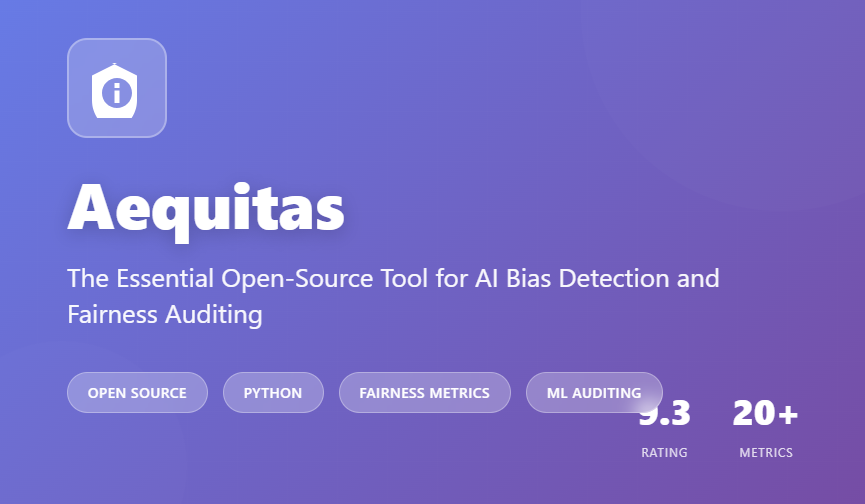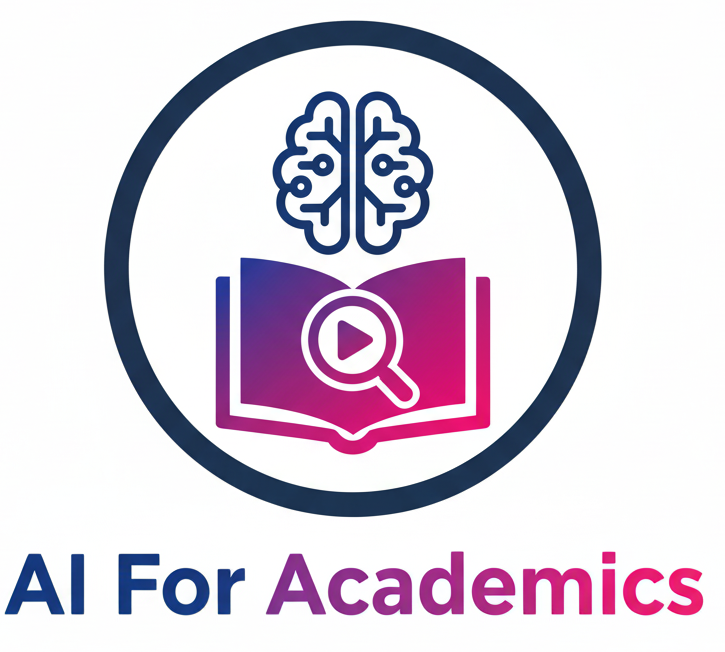In an era where artificial intelligence increasingly influences critical decisions in hiring, lending, criminal justice, and healthcare, having a reliable AI bias detection tool has become paramount. Enter Aequitas, a powerful open-source Python toolkit designed specifically as an AI bias detection tool to help data scientists, developers, and auditors identify and mitigate bias in AI systems.

What is Aequitas?
Aequitas (Latin for “fairness” or “equity”) is a comprehensive bias and fairness audit toolkit developed by the Center for Data Science and Public Policy at the University of Chicago. This Python-based tool enables practitioners to systematically evaluate machine learning models for discriminatory patterns across different demographic groups.
Unlike generic analytics tools, Aequitas specifically focuses on fairness metrics that matter in real-world applications, making it an indispensable resource for organizations committed to responsible AI deployment.
Why AI Bias Detection Matters
Before diving into Aequitas’s capabilities, it’s crucial to understand why bias detection in machine learning is non-negotiable:
- Legal compliance: Regulations like the EU AI Act and proposed US legislation require fairness audits
- Ethical responsibility: Biased algorithms can perpetuate historical discrimination
- Business risk: Unfair models can lead to lawsuits, reputation damage, and loss of customer trust
- Model performance: Bias often indicates underlying data quality issues affecting overall accuracy
Key Features of Aequitas
1. Comprehensive Fairness Metrics
Aequitas supports multiple fairness definitions, recognizing that “fairness” isn’t one-size-fits-all:
- Statistical parity: Are positive outcomes distributed equally across groups?
- False positive/negative rate parity: Are error rates consistent?
- Predictive parity: Are positive predictions equally accurate for all groups?
- Equalized odds: Does the model perform equally well regardless of group membership?
2. Interactive Visualization
One of Aequitas’s standout features is its visualization capabilities. The tool generates:
- Disparity charts: Clear visual comparisons of how models perform across demographic groups
- Fairness trees: Decision-support visualizations showing which fairness criteria are met or violated
- Bias reports: Comprehensive dashboards highlighting areas of concern
3. Multiple Protected Attributes
Aequitas can simultaneously analyze fairness across various protected characteristics:
- Race and ethnicity
- Gender identity
- Age groups
- Geographic location
- Any custom demographic categories in your dataset
4. Easy Integration
As a Python library, Aequitas integrates seamlessly with popular data science frameworks:
python
# Simple integration example
from aequitas.group import Group
from aequitas.plotting import Plot
# Analyze your model predictions
g = Group()
xtab, _ = g.get_crosstabs(df)
# Visualize disparities
p = Plot()
p.plot_disparity(xtab)How to Use Aequitas: A Practical Workflow
Step 1: Install and Import
bash
pip install aequitasStep 2: Prepare Your Data
Aequitas requires a dataset with:
- Model predictions (scores or binary classifications)
- Actual outcomes (ground truth labels)
- Protected attribute information
Step 3: Generate Fairness Report
Run Aequitas to produce a comprehensive audit showing:
- Which groups face disparate impact
- Magnitude of disparities
- Which fairness definitions are violated
Step 4: Take Action
Based on the audit, you can:
- Retrain models with fairness constraints
- Adjust decision thresholds by group
- Collect more representative training data
- Apply bias mitigation techniques
Real-World Applications
Criminal Justice
Courts and parole boards use risk assessment tools to make decisions about bail and sentencing. Aequitas helps ensure these tools don’t discriminate based on race or socioeconomic status.
Financial Services
Banks use ML models for loan approvals and credit scoring. Aequitas audits can verify compliance with fair lending laws like the Equal Credit Opportunity Act.
Hiring and Recruitment
Resume screening algorithms must avoid discrimination. Aequitas helps HR departments identify if their AI tools disadvantage certain demographic groups.
Healthcare
Predictive models for patient risk and treatment recommendations need to work equally well for all patient populations. Aequitas can reveal if certain groups receive substandard risk assessments.
Aequitas vs. Alternatives
FeatureAequitasFairlearnAI Fairness 360Open Source✓✓✓VisualizationExcellentGoodExcellentFairness Metrics20+10+70+Learning CurveLowMediumHighIntegrationPythonPython/Scikit-learnPython/R
While tools like Fairlearn (Microsoft) and AI Fairness 360 (IBM) offer bias mitigation algorithms, Aequitas excels at comprehensive auditing and visualization, making it ideal for initial bias detection and reporting.
Limitations to Consider
Despite its strengths, Aequitas has some constraints:
- Requires labeled data: You need ground truth outcomes, limiting use on production data without feedback loops
- Python-only: Not accessible for teams working in other languages
- Post-hoc analysis: Focuses on detecting bias rather than preventing it during training
- Technical expertise needed: While user-friendly, it still requires data science knowledge
Getting Started with Aequitas
For Data Scientists
- Documentation: Visit the official Aequitas documentation
- GitHub repository: Explore examples and contribute at github.com/dssg/aequitas
- Tutorials: Work through Jupyter notebook tutorials included in the repo
For Organizations
- Establish fairness requirements: Define what fairness means for your use case
- Integrate into ML pipeline: Make Aequitas audits part of your model validation process
- Train your team: Ensure data scientists understand how to interpret fairness metrics
- Document findings: Maintain audit trails for compliance purposes
Best Practices for AI Fairness Auditing
Using Aequitas effectively requires more than just running the tool:
- Define fairness contextually: Different applications may require different fairness criteria
- Audit regularly: Bias can emerge over time as data distributions shift
- Combine with domain expertise: Technical metrics should inform, not replace, human judgment
- Consider intersectionality: Examine combinations of protected attributes, not just individual ones
- Be transparent: Share audit results with stakeholders and affected communities
The Future of AI Fairness Tools
As AI regulation evolves globally, tools like Aequitas will become increasingly essential. Emerging trends include:
- Automated fairness monitoring: Real-time bias detection in production systems
- Standardized fairness reporting: Industry-wide frameworks for documenting fairness audits
- Expanded metrics: New fairness definitions addressing emerging concerns
- Integration with MLOps platforms: Fairness checks built into model deployment pipelines
Conclusion: Why Aequitas Matters
In a world where algorithms make high-stakes decisions affecting people’s lives, Aequitas provides an essential safeguard. This open-source tool democratizes access to sophisticated fairness auditing, enabling organizations of all sizes to:
- Identify bias before it causes harm
- Meet regulatory compliance requirements
- Build trust with users and stakeholders
- Develop more robust, equitable AI systems
Whether you’re a data scientist building predictive models, a compliance officer ensuring regulatory adherence, or an executive responsible for ethical AI deployment, Aequitas offers the transparency and rigor needed to operationalize fairness in machine learning.
The question is no longer whether to audit AI systems for bias, but how to do it effectively. Aequitas provides a proven, accessible answer.
Frequently Asked Questions
Q: Is Aequitas free to use?
A: Yes, Aequitas is completely free and open-source under the MIT license.
Q: Do I need to be a machine learning expert to use Aequitas?
A: While some technical knowledge helps, Aequitas is designed to be accessible. Basic Python skills and understanding of your data are the main prerequisites.
Q: Can Aequitas fix bias in my model?
A: Aequitas is primarily an auditing tool that detects bias. While it doesn’t automatically fix issues, its insights guide you in applying appropriate bias mitigation strategies.
Q: How long does a fairness audit take?
A: With prepared data, running an Aequitas audit typically takes minutes. Interpreting results and deciding on remediation requires more time and expertise.
Q: Does using Aequitas guarantee legal compliance?
A: While Aequitas helps identify potential fairness issues, legal compliance requires consultation with legal experts familiar with relevant regulations in your jurisdiction.
Ready to ensure fairness in your AI systems? Explore Aequitas and other essential AI ethics tools on our platform. For more resources on responsible AI development, check out our comprehensive guides on bias mitigation and algorithmic accountability.

Leave a Reply